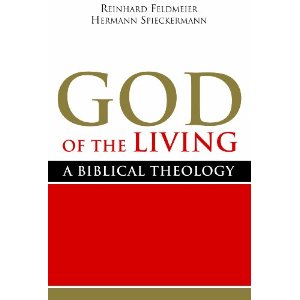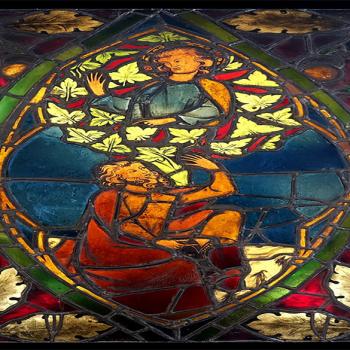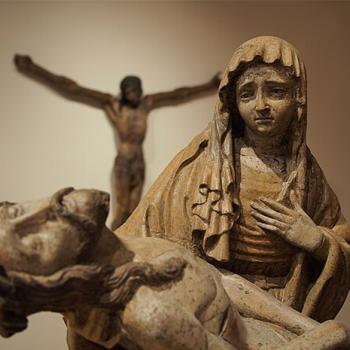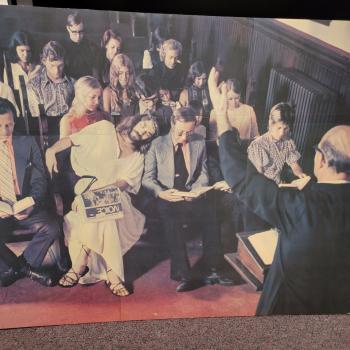——
Feldmeier and Spieckermann have produced for us a magnificent study that is surely to become the bench-mark and reference point for our on-going work in biblical theology. It is an enormously ambitious undertaking, as they themselves acknowledge that the mastery of both testaments in a common study requires more than one scholar; the mass and complexity of the material is surely beyond the scope and capacity of any single scholar. The format of the work is a brilliant and comprehensive tracing of themes from Old to New Testament in a way that evidences both the deep continuity of the two, and the venturesome theological advances readily evident in the move from the Old to the New Testament. Their work, moreover, is enormously complex so that response to it is not easy or obvious. I note at the outset that they proceed with critical assumptions about the dating and context of texts that are more contested than they articulate, and their propensity is to draw as many texts as possible to the Hellenistic period, a decision that as a byproduct serves all the better to show the connections to the New Testament. Because their work is complex and stunningly comprehensive, I have decided to focus on three of their chapters that particularly interest me, chapters that I believe are representative of the way in which this analysis and argument work.
First, I will reflect on chapter 2 (pp. 51-91) entitled “From Lord God to Father God.” The work of the chapter is to trace the way in which an accent on “God as Father” becomes clearer in the latter part of the Old Testament and central and dominant in the New Testament. It is the thesis of the chapter that the title of “God as Lord” is compellingly and cunningly displaced by the usage of “God as Father.”
While ancient Near Eastern religion generally speaks of God as Father, Feldman and Spieckermann note that the Old Testament is “reticent” about such usage of which they cite only seventeen cases in the Old Testament (p. 52). These uses appear, first of all, in the royal language that focuses on the primary oracle of II Samuel 7:1-16 and then in the derivative Psalm 89 wherein David and his line are identified as Son of the Father God.
This parental language takes on “new significance” in the exilic and post-exilic periods when Israel no longer had the stated structures of dynasty and temple to sustain and embody more lordly language. A new sense of vulnerability evokes in the on-going tradition God as the Father of displaced “children” that leads to a new definition of the relationship. Among the more important texts are those cited from Psalm 103:10-14 and most especially Isaiah 63:15-64:11 wherein father language makes possible an accent on mercy and parental comfort. They further trace that rhetoric in Tobit 13 where “our father” disciplines and shows mercy, and in Ben Sirach 51 where God the father is “my salvation.”
In his Theologies of the Old Testament Erhard Gerstenberger comes to the same conclusion, though with a much greater accent on the institutional crisis of Judaism and the sociological evocation of the usage:
By contrast the God whom one can address as “father” and who does not listen (or no longer listens) to the majestic and warlike appellations (king of kings, lord of lords, judge, creator of heaven and earth, rider on the clouds, etc.) is basically a near God to whom there are personal ties (cf. Isaiah 63:7-64:11)…the much-vaunted characteristics of Yahweh indicating his friendliness toward human beings are largely to be regarded as a legacy of family theology.1
And of the verses in Psalm 103, Gerstenberger comments:
“What a difference from the bureaucratic and also “impartial” reckoning of guilt of a large society and its theologians!…In other words, secondary organizations which act by justice and law, without respect of persons, cannot practice any mercy. Forgiveness and care come to bear only in direct human relationships, as unbureaucratic promptings “from the belly, with compassion” (Hebrew rehem, womb), as must be the case in the solidarity of intimate groups. Large organizations are incapable of this.”2
Thus the emerging rhetoric of fatherhood is congruent with a social setting that left the community vulnerable and without strong, centralized institutional support .Gerstenberger’s sociology, to my mind, greatly illuminates the interpretive judgment made by Feldmeier and Spieckermann.
In the New Testament the imagery of father is much more prominent on order to serve 1) Christological claims for the Sonship of Jesus, 2) soteriological claims for “the children of God,” and 3) the ethical consequences for the “children of obedience.” (67). Indeed Jesus, they say, speaks of God as king only in the parables and in Mark 3:35.3 The survey of such rhetoric includes attention to Paul with reference to Galatians 4 and Romans 8 (“Abba,” father). More central is the usage in the Gospel of Luke wherein Jesus refers to “my father’s house” and twice calls on the father from the cross. More expansively the Johannine corpus is preoccupied with the relationship of the father and the son, and eventually includes in the familial imagery believers as “God’s children” (I John 3:1).
It is true that all of this textual data has been there for us before. But that is how we proceed in our interpretive community. It is the acute attentiveness of Feldman and Spieckermann that shows us afresh how this textual data converged to function as a remarkable and innovative articulation as a way to insist upon “God’s saving attention in the midst of the experience of God’s distance.” (53) They trace the increase of such usage through the literature of the New Testament that evidences “an increasingly more consistent christological definition of the understanding of God” in the New Testament (53). Such usage not only affirms the centrality of the Son, but exhibits the father very differently in the church and in the world.
In a quite fresh notice that exposits the explosion of “the purely masculine associations of the father metaphor,” with reference to Clement of Alexandra with a citation of I Peter 1:23-25, and 2:2, they judge that the father who loves “manifests female characteristics.” (p. 85) Along with these evidences, they might also have cited Numbers 11:12 where Moses vigorously protests the wilderness circumstance of Israel:”
“Did I conceive all this people? Did I give birth to him, that you should say to me, “Carry them in your bosom as a nurse carries a suckling child?”
The imagery clearly suggests that it is God the mother who conceived, who birthed, and who now has responsibility for the offspring. It is indeed curious that for such daring mothering usage, the tradition is evidently reluctant to use nouns that go properly with such narrative characterizations. We are left with clear attestation of the mothering one who continues to be called father.
I respond to this remarkable articulation by our authors in three observations:
1. Paul Ricoeur, with an important appeal to Freud, has long ago traced the use of the father imagery for God in the Bible:
a) He begins:
All men used to call God their father—this is the initial given; it is even an immense banality.4
b) But the father figure, before making a return, must perforce recede and is treated with huge “reserve” in the Old Testament, because the God known there is not to be identified with the generative father of the Ancient Near East.
c) In a return of the father who has been broken by reserve, the evangelical usage of “abba” is “absolutely unprecedented and without parallel in all the literature of Jewish Prayer.”5
Jesus dares to address himself to God as a child to his father. The reserve to which the whole Bible testifies is broken at this precise point. The audacity is possible because a new time has begun. Far, therefore, from addressing God as father being easy, along the lines of a relapse into archaism, it is rare, difficult, and audacious, because it is prophetic, directed toward fulfillment rather than toward origins. It does not look backward, toward a great ancestor, but forward, in the direction of a new intimacy on the model of the knowledge of the son.6
Thus Ricoeur suggests that the New Testament usage is eschatological, in anticipation of what this father will make possible by way of parental mercy. This is congruent with the evidence of Feldmeier and Spieckermann, but I suggest that an accent on the daring audaciousness of such usage is an audaciousness of hope, long before Obama, hope offered among the vulnerable who are without hope in the world. Such an audacious hope could only be voiced and enacted once the father had been broken away from conventional, banal use.
2. The thesis that Feldmeier and Spieckermann advance is compelling. But I wonder if the line of development is as singular as they suggest. In the move from “lord” to “father,” I wonder if we do not need to see that the images converge and mutually correct, inform, and enforce each other rather than standing in sequence. Clearly the images are used together, as we pray “Our Father,” but then we quickly pray after that, “Thy Kingdom come,” and we finish with a royal flourish:
For thine is the kingdom and the power and the glory forever and ever. Amen.
I wonder if the images are as clear and singular as suggested.
It is important in my judgment, moreover, that the language of sovereignty not be abandoned, because without it the faith can devolve, at least in the United States, into something like maudlin romanticism. Of course these authors did not intend or imply any such thing. Thus fatherhood, I suggest, must be fully appreciated, but within a matrix of images that also will call to account by a God who will not be mocked. The move from lord to father thus is complex and requires a collage of images.
3. It occurs to me that the imagery of father is just now, in our society, pastorally urgent and engaging, not unlike in the time when the Jews were left vulnerable with loss of temple and dynasty. The loss in our society, signified by 9/11, the economic collapse, the inability to win a war, and the dysfunction of public institutions, accompanied by a broad and deep moral collapse is enough that discerning people can indeed, in secret if not in public sing, “Sometimes I feel like a motherless child. Thus the articulation and enactment of the father God is an important response and antidote to that lived reality. Ancient Israel, amid doxologies of God’s victory over chaos and in combat, can affirm:
Father of orphans and protector of widows
is God in his holy habitation (Psalm 68:5).
And the doxology of Israel is matched by the assurance of the departing Jesus:
I will not leave you orphaned. I am coming to you (John 14:18).
What these authors evidence exegetically matters enormously for the sustenance of serious faith in our time and place.
II.
Second, chapter 5 exposits the notion of “the Almighty,” the power and the sovereignty of God (pp. 147-199). The authors quickly dispose of the notion of divine absolute omnipotence that was alive and well in common Near Eastern theology, as it is alive and well in much popular religion in our own time. The beginning point of the discussion is that Israel’s affirmation about God begins with the notion limit and contestation that of course prepares the ground for the insolvable question of theodicy. But because God, for Israel, is a living character in the real drama of life, God is in relationship and never to God’s self alone. God must always again confront “the numinous powers that threaten the world on a cosmic level” (p. 151) This leads to an extended and suggestive exposition of Psalm 93, an Enthronement Psalm, as well as Psalms 24 and 84. The dramatic force of this liturgical scenario of enthronement and governance is such that YHWH must be ready “to defend his status” against competitors and rivals. (157) The discussion pivots on the phrase “YHWH Seba’ot, a phrase that bears witness to God’s glory, power, and majesty; but that claim of splendor is always contested and must be re-performed, not a flat given that is a fixed base line in the life of God or in the life of the world.
The authors take great care to distinguish this relational dynamic form of “almighty” from abstract forms of omnipotence. Happily they offer us an extended commentary on the Almighty in the book of Job and then probe what happens as YHWH seba’ot is translated, according to Hellenistic requirement, into pantokrater that noticeably shifts the ground of the divine claim.
Most important to me are three statements by the authors concerning the claims of the almighty:
1. The authors state:
This circumstance [of names for God that indicate relationships] determines the understanding of the power of the Jewish God. It is not a potentia absoluta, but a potentia personalis sive relationis. It applies in prayer and in judgment, in struggle and in hope (172).
One notices immediately the terms “prayer and judgment, struggle and hope.” That is, the power of YHWH is enmeshed in the processes of history, in the administration of justice (judgment), in the intimacy of relatedness (prayer), in the present reality of struggle, and in the future possibility of hope. The authors avoid the term “covenantal,” later on treating “covenant” as a quite marginal issue in the Old Testament. But if one does not want to dwell on the notion of covenant, then the matter is at least dialogical and interactive, and deeply contextual in a way that recharacterized omnipotence as “attentive care.” Clearly the notion of “almighty” is deeply reconstituted according to the force of YHWH in the life of the world and the life of Israel.
2. In one of the shrewdest of their comments on the theme, they write:
The mighty do not speak of the Almighty. Victims, sufferers, who hold fast to the power of their God in their own powerlessness and who, thus, open themselves de profundis to a new confidence in God, speak of the Almighty. Language about the Almighty ultimately becomes the expression of confidence and hope in the “all-helper.” A glance at the genres in which this designation for God dominates confirms this view. It does not appear in theological speculation or even political religion, but in petition and encouragement, lament and praise. It Sitz im Leben is the appeal to God as helper (p. 175).
They make a decisive differentiation between the mighty (here meaning mighty human power, but it could be extended to other mighty gods) and victims and sufferers. The differentiation fits with God’s “preferential option for the poor,” only here the matter is inverted. Now it is the preferential option of victims and sufferers who “prefer” the helping power of YHWH, and who choose to engage with and address YHWH among all the available gods. Their situation, unbearable as it is, permits a new openness, de profundis, to new confidence in this God. Thus the “almighty” is the “all-helper.” The victims of injustice shun theological speculation that is a luxury they cannot afford. They avoid political religion, though we must allow that in a quite alternative cadence their engagement with YHWH is acutely political as well. Their preferred genres are lament and praise, praise after lament, lament first that draws God to their need as a helper.
Thus the sense of this remarkable paragraph is that almightiness is a claim suitable to the genre of lament; it is lament that evokes and requires an appeal to the almighty. In Israel’s signature narrative, the initial exchange of Exodus 2:23-25 makes the point. Israel in its oppression cries out; in response YHWH is mobilized with power to overthrow the system of Pharaoh. It is a commonplace to notice, moreover, that the cry of these sufferers is not addressed to YHWH; YHWH nonetheless heard and took notice so that the “connect” of the almighty with the victims and those who suffer is made from YHWH’s side, not from the side of the victims. This is divine righteousness that extends itself, that becomes engaged, and that puts reality into contestation. And of course the exchange of “cry-hear” is reiterated many times in the Psalms, not least in the four-fold testimony of Psalm107 that is repeatedly “they cried…he delivered” (vv. 6, 13, 19, 28).
The other preferred genre of victims and sufferers is praise, the doxology that allows the exhibit of and engagement with the almighty power that resists and answers the threat of chaos. Lament and praise are perforce remote from theological speculation and political theology of any ordinary kind. They are elusive weapons of the weak that cannot be contained in either theological speculation or conventional political religion.7
I would make one modification to this remarkable statement of Feldmeier and Spieckermann. They judge that the mighty do not speak of the almighty, not speak by way of lament or praise. Indeed, the mighty do not speak lament. But they do speak praise; it is praise that lacks engagement and that does not host the stress that goes with contestation, even if it contestation that is resolved. The praise of the mighty tends to be immune to any awareness of contestation. The praise of the victims and sufferers, in contrast with the praise of the mighty, is filtered and processed through lament. In the end, language about God’s almightyness, because it is on the lips of the victims and sufferers is increasingly “contrafactual” (p. 176). The term “contrafactual,” used by these authors, is enormously important, because the mighty always traffic in the factual and resist that contra through which the victims find voice.
3. The argument is summarized in yet another way:
In prayer and petition, in praise and lament, in encouragement and promise, the discussion of God’s unbounded possibilities does not refer to abstract superiority, but confesses or invokes God as helper and savior who has bound himself to his people. In the biblical context, therefore, almightiness is not unbounded omnipotence, but a power expressed in God’s will for the salvation of his people. (p. 197).
A decision for the rhetoric of prayer, petition, praise and lament is already a decision against “unbridled omnipotence.” The sentence I have quoted precisely juxtaposes “God’s unbounded possibility” and “unbridled omnipotence.” I do not know how much traffic the authors intend the term “possibility” to carry, but it seems to me exactly the right word. The term “possibility” together with its counterpoint, “impossibility,” (pela’, too difficult, too wonderful, too hard) puts God’s power in the service of transformative generativity and rescue. Thus already in Genesis 18:14 the “impossibility” that becomes possible is an heir promised to Abraham and Sarah so to open their future beyond their present circumstance of hopelessness. In the juxtaposed prayer and oracle in Jeremiah 32, moreover, the text voices the possibility of the almighty that, by historical circumstance, is impossible. Thus the prayer of Jeremiah begins:
“Ah Lord God! It is you who made the heavens and the earth by your great power and by your outstretched arm! Nothing is too hard for you (Jeremiah 32:17).
And the responding oracle of YHWH begins:
“See, I am the Lord, the God of all flesh, is anything too hard for me? (Jeremiah 32:27).
Both the prayer and the oracle culminate with the assurance that YHWH will return defeated, displaced Israel to its homeland. At the end of the prayer:
Yet you, O Lord God have said to me, “Buy the field for money and get witnesses”-though the city has been given into the hands of the Chaldeans (v. 25).
And the end of the oracle:
“See, I am going to gather them from all the lands to which I drove them in my anger and my wrath and in great indignation; I will bring them back to this place, and I will settle them in safety. They shall be my people, and I will be their God. I will give them one heart and one way, that they may fear me for all time, for their own good and the good of their children after them vv. 37-39).
The entire map of God’s power—extended in the oracle to Mary that “nothing will be impossible with God” (Luke 1:37)—is in the service of salvation, for Abraham and Sarah, for displaced Israel, and for the company of the needy in Luke.
In the New Testament, as these authors comment, Paul fully exposits the gospel riddle of strength through weakness that pivots on the cross but that culminates in Easter. Thus the cadences of lament and praise serve the weakness of Friday and the strength of Sunday. Particular attention is devoted to the Pauline lyric of II Corinthians 6:18 but even this attestation to the “Lord almighty” is situated in the fatherliness of the almighty, thus an almightiness marked by intimate attentiveness:
I will be your father
and you shall be my sons and daughters,
says the Lord Almighty.
The Pauline lyric, moreover, is brought by our authors to concreteness in the summons to discipleship in Mark 10. Thus Jesus calls the ones who would be greatest to be servants. Our authors continue to walk around the temptation in the text and in our reading of the text to “absolute power per se.” (p. 197) But they judge that even the creed with its pantocrater subverts this temptation, by assigning and subordinating omnipotence to the “Father.” (p. 197).
In pondering these rich statements, I find it useful to consider again Ricoeur’s grid of symbol, broken symbol/restored symbol with reference to God’s power.
1. There is absolute power attributed to the gods, and in some of the hymns of Israel, there is appeal to that doxological tradition, perhaps as in the Song of Moses and the Song of Miriam (Exodus 15:1-18, 20-21). Even there, however, the claim is not necessarily absolute, but rather evidence of a contested case and its outcome.
2. But as these authors contend, such a divine claim is broken. It is, in Israel, broken in narrative and in poetry by the attestation of Israel. I have elsewhere suggested that in the Ark Narrative of I Samuel 4-6, the power of YHWH was dramatically broken as YHWH became a captive and prisoner of Dagon.8 For an instant, “the glory had departed” (see I Samuel 4:22) Of course, the narrative does not leave it so. It is on “the third day” that the arms of Dagon are completely broken; YHWH is free to head home (I Samuel 5:4). It is an exodus of YHWH from Philistine bondage. It is not, however, merely an emancipation for YHWH. The Israelites who witness the dramatic homecoming of YHWH in glory rejoice, because it is an emancipation Israel as it is for YHWH (I Samuel 6:13).
The same breaking of absolute divine power is evident in the prophetic tradition that attest to YHWH’s deep pathos by which YHWH must move beyond blustering self-regard to attentiveness to Israel. The prize case for such broken divine bluster is in the poem of Hosea 11:1-9 in which YHWH, between verses 7 and 8 reverses rhetoric and resolves to be God and “not human,” and so entertains transformative work. By divine absoluteness Israel may indeed be destroyed (vv. 5-7); but by the radical repositioning of divine agency, the future of Israel is radically transformed.
Israel knows about the brokenness of God’s power in its exilic laments:
My way is hidden from the Lord,
and my right is disregarded by my God (Isaiah 41:27).
The Lord has forsaken me,
my Lord has forgotten me (Isaiah 49:14).
Is my hand shortened that it cannot redeem?
Or have I no power to deliver (Isaiah 50:2; see 59:1).
3. But of course, the abuse and ineffectiveness and feebleness of YHWH are then overcome as YHWH is bestirred to saving action. The three despairing complaints of Israel are vigorously answered by YHWH:
Have you not known? Have you not heard?
The Lord is the everlasting God,
the creator of the ends of the earth (Isaiah 41:28).
Even these may forget you,
yet I will not forget you.
See, I have inscribed you on the palms of my hands;
your walls are continually before me (Isaiah 49:15-16).
By my rebuke I dry up the sea,
I make the rivers a desert;
their fish stink for lack of water and die of thirst. (Isaiah 50:2).
YHWH declares, moreover, that YHWH’s time of dormancy is ended; and YHWH will again be engaged in transformative action on behalf of Israel:
For a long time I have held my peace,
I have kept silent and restrained myself;
now I will cry out like a woman in labor,
I will gasp and pant… (Isaiah 42:14).
For Zion’s sake I will not keep silent,
And for Jerusalem’s sake I will not rest,
Until her vindication shines out like the dawn,
And her salvation like a burning torch (Isaiah 62:1).
The movement from power to brokenness to transforming power is reiterated over and over in the texts of Israel. It culminates, in Christian confession, in the triduum of Friday, Saturday and Sunday.9 Surely as Alan Lewis has judged, we Christians do well to linger longer over Saturday.10 Methinks that the common liturgical rush past Saturday, the day of divine enfeeblement, enacts a lust to return to absolute divine power that is deeply interrupted by Friday. There is, however, no return to such power, given the loss of Friday and the depth of Saturday.
As a footnote, I add a mention and wonderment about Mark 6:5-6. Jesus returns to Nazareth where people are dazzled by him. And then the narrative reports:
And he could do no deeds of power there, except that he laid his hands on a few sick people and cured them. And he was amazed at their unbelief (Mark 6:5-6).
The sequence of terms is “not able…deeds of power…unbelief.” The sequence makes clear that the power of Jesus is not absolute, but is profoundly at risk and dependent on his partners in need. Their hard-heartedness can defeat salvific divine power! The narrative suggests that transformative power is a transactive process in mutuality, and not a unilateral performance. The sketch of divine power by Feldmeier and Spieckermann is of immense importance in a world enthralled by power of an absolute kind that has no capacity for transformation.
III.
Third, chapter 11 is a brief discussion of divine hiddenness and wrath (pp. 339-360). I take up this particular chapter because I find the subject endlessly demanding and vexing. Every Old Testament teacher gets asked about the themes of divine wrath and violence all the time.
Concerning the Old Testament, this chapter makes two compelling points. First, the hiddenness and wrath of God are real and deeply impact the life of Israel and the life of the world. But second and more important to these authors, these negating actions of God are limited and there is a radical asymmetry between divine wrath and divine love:
Accordingly, the New Testament says that God is a God of love (2 Cor 13:11), indeed, that he is love (1 John 4:8, 16), while the contrary statement, that he is a God of wrath, indeed, that he is wrath, is inconceivable. One can even intensify this clear asymmetry between wrath and love and between hiddenness and revelation further. God hides and grows angry because of his love and of the sake of his love. It must, therefore, be asserted emphatically that God’s wrath is his reaction to injustice and defiance (see Rom 1:18), not a divine affect, not one of God’s dark sides, and certainly not a divine attribute (pp. 339-340).
The authors are at pains to acknowledge the deep reality of divine hiddenness and wrath:
In human experience, being forgotten by God, like the concealment of his countenance, is not a passing act of divine punishment, which, like an emotion, has a trigger and a foreseeable end. Finality characterizes both God’s gracious and wrathful activity. The question “How long?” seeks to limit an experience that endured “forever.” (p. 342).
That finality pertains, for ancient Israel, especially to the sixth century crisis:
The national catastrophe of 587-586, in particular, is a paradigm for the fact that a historical event can acquire the status of a conclusive act of God…the experience of God’s distance associated with the fall of Jerusalem continued to be a valid reference for understanding other dark experiences of God (p. 343).
That experience cut theologically educated Judeans and Jerusalemites to the quick. These texts shatter the theological system that teaches one to understand God as “slow to anger” because, according to his nature and action, God’s goodness has prevailed without doubt to this point. Now, however, hiddenness and wrath seem to have assumed prominence…one can no longer avoid interpreting the hiddenness of God as either definitive alienation or complete depletion (p. 344).
The outcome is a deep theological crisis that is replicated as personal experience in the Psalms.
But such experience is momentary and love wins! Thus in Isaiah 51, the cup of wrath is removed. The experience of deep divine abandonment is for the “moment” (Isaiah 54:7-8):
Weeping may linger for the night,
But joy comes in the morning (Psalm 30:5).
That reality and that limitation lead to the conclusion that such dark times are “instrumental”:
Hiddenness and wrath are instrumental and intentional divine behaviors; they are means to the goal of reestablishing his betrayed love. When this instrumentality of hiddenness is overlooked, the danger lurks of making the biblical concept of God into a caricature (pp. 340-341).
The authors conclude:
God’s activity is not psychologized or relativized historically (p. 342).
I do not know what such a statement might mean. The intent, apparently, is to distance such performance from the being of God. But all we have is image and metaphor. And if we are to remain inside the imagery, then one cannot, so it seems to me, deny a psychological dimension to the reality of God or refuse to situate the reality of God in historical context. The project that seeks to define such divine performance as instrumental and uncontaminated by the vagaries of contextual reality seems to me a declaration, one almost always made in Christian theology, but not an argument. The outcome is to protect God from the full implication of God’s own action.
I want first to thank Feldmeier and Spieckermann for their candor and care about this problem that remains a problem for all of us. They do not take the popular, liberal out of seeing such hiddenness and wrath in textual testimony as human projection, albeit mistaken human projection. Nor do they take refuge in an evolutionary hypothesis, as is usual, to say it may have been so primitively in a way that no longer pertains. They take the testimony as full, serious theological disclosure, a welcome steadfastness.
I have no doubt, moreover, that we can readily point to this “second move.” Israel readily makes that move to talk about the transformative resolution at the end. I follow this genuinely serious interpretation and am appreciative of it. And yet I am uneasy. I am not especially concerned about their particular argument, but about a more general propensity among us to protect God from God’s self in which this argument participates. And I wonder if a resolution in this direction is not a pastoral deception, and if it is a pastoral deception, then it is theologically problematic.
The authors acknowledge that “in human experience” such matters have finality. But then they quickly add, with reference to Isaiah 54:7-8, that it is “for the moment.” But of course in Isaiah 54 the “moment” is for forty years, two generations, more than the life-time of the generation that was deported. Thus I wonder if we do not participate in a theological finesse not unlike that of Job’s friends who require Job to deny his own experience of divine hiddenness and wrath so that at the end of the process God is vindicated.
I sympathize with this move and can see it at many points in the text; but I am uneasy. I am uneasy because that slotting such divine violence as “instrumental” does not go all the way into divine violence and rage. On the one hand, the violence against the indigenous population of Canaan at the behest of YHWH is in the service of the chosen people for the sake of the chosen land. I have come to think of late that such chosenness on the part of YHWH has a pernicious dimension that it is not simply an ideological mistake on the part of Israel, but is a defining mistake on YHWH’s part.11 While such violence is surely “redeemed” in the horizon of Israel, it is not for the displaced population of the land. And all of that at the behest of YHWH!
Or second, more immediately concerning Israel, in Ezekiel 16:35-43 YHWH “loses it” with reference to obdurate, faithless Israel:
“Therefore, I will gather all your lovers, with whom you took pleasure, all those you loved and all those you hated; I will gather them against you from all around, and I will uncover your nakedness to them, so that they may see all your nakedness. I will judge you as women who commit adultery and shed blood are judged, and bring blood upon in wrath and jealousy. I will deliver you into their hands, and they shall throw down your platform and break down your lofty places; they shall strip you of your clothes and take your beautiful objects and leave you naked and bare. They shall bring up a mob against you, and they shall stone you and cut you to pieces with their swords. They shall burn your houses and execute judgments on you in the sight of many women; I will stop you from playing the whore, and you shall also make more payments. So will satisfy my fury on you and my jealousy shall turn away from you. I will be calm, and will be angry no more” (vv. 37-42).
This is divine emotional outrage that falls, in my judgment, well outside of any symmetry that has a goal of “reestablishing his betrayed love” (p. 341). YHHW is simply mad in a way that falls outside Deuteronomic symmetry of guilt and punishment. This divine articulation is, in my judgment, an extreme emotional overreach that runs well beyond the intentional. Now I know that verse 53 promises restoration:
I will restore their fortunes, the fortunes of Sodom and her daughters and the fortunes of Samaria and her daughters, and I will restore your own fortunes along with theirs (Ezek. 16:53).
But in the end, even that resolve continues:
in order that you may bear your disgrace and be ashamed of all that you have done … (v. 54).
That in turn is followed in verse 60 with a “yet” that culminates in forgiveness:
Yet I will remember my covenant with you in the days of your youth, and I will establish with you an everlasting covenant…I will establish my covenant with you, and you shall know that I am the Lord, in order that you may remember and be confounded, and never open your mouths again because of your shame, when I forgive you all that you have done, says the Lord God (vv. 60-63).
Such a response comes very late. A wise old nun, without a shred of innocence, told me that such divine rage is only possible because of passionate divine love.
Perhaps so. It seems to me, however, that the God we have here is not so easily slotted with such complete redemptive intention. The generation that received the emotional outburst is not much comforted, I hunch, by the much later “yet.” I believe that in a world of technological reductionism that we do better to exposit with candor the open, unresolve of fidelity that is always under contestation. To try to voice coherent resolution to the rawness of holy self-disclosure seems to me is exactly to try for settle for “theological speculation” that is the work of “the mighty” and not that of the victims and sufferers, as we have seen in chapter 5 (p. 175).
This is not, from my perspective, a dispute with this book or with these authors. It is rather a more fundamental uneasiness that perhaps does no more than exhibit my inability to think theologically. It is true now, as in that ancient community, that we may with our left hand (or right brain) think that violence and hiddenness are to be honored all the way down. It is engagement with that “finality,” without resolve, that may lead to “joy in the morning.”
You will notice, in my exposition, my deep appreciation to Feldmeier and Spieckermann, and my gratitude for the ways in which they have pressed and evoked my thinking afresh. They end their book with that great doxology of Psalm 118 concerning the God who does not abandon. While we make that claim for God alongside Israel, we also must struggle, as these authors know, with the specificities of life in all its historical, psychological, sociological, political, and economic dimensions that refuse to conform to our best formulations. We must of course continue our best formulations; but they cannot be very far away from what we know of lived reality. These authors know that very well, and I am glad that I know it along with them.
Walter Brueggemann
Columbia Theological Seminary
November, 2011, SBL San Francisco
Notes
1. Erhard S. Gerstenberger, Theologies in the Old Testament (Minneapolis: Fortress Press, 2002) 56-57.
2. Ibid. 57-58.
3. The reference on p. 66, n. 44 is mistakenly given as Matthew.
4. Paul Ricoeur, The Conflict of Interpretations (edited by Don Ihde; Evanston: Northwestern University Press, 1974) 483.
5. Ibid. 490.
6. Ibid, 490-491.
7. I make intentional reference to James C. Scott, Weapons of the Weak: Everyday Forms of Resistance (News Haven: Yale University Press, 1985). See as well Richard Horsley editor, Hidden Transcripts and the Arts of Resistance: Applying the Work of James C. Scott to Jesus and Paul (Semeia Studies; 48; Atlanta: Society of Biblical Literature, 2004).
8. See Walter Brueggemann, Ichabod Toward Home: The Journey of God’s Glory (Grand Rapids: Eerdmans, 2002).
9. See Hans Urs von Balthazar, Mysterium Paschale: The Mystery of Easter (Grand Rapids; Eerdmans, 1990).
10. Alan E. Lewis, Between Cross & Resurrection: A Theology of Holy Saturday (Grand Rapids: Eerdmans, 2001).
11. On the “ordeal” of chosenness, see Todd Gitlin and Liel Leibovitz, The Chosen Peoples: America, Israel, and the Ordeals of Divine Election (New York; Simon & Schuster, 2010).

















